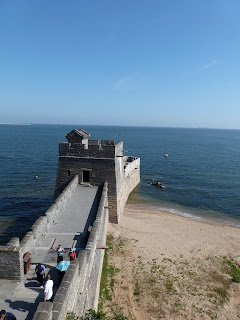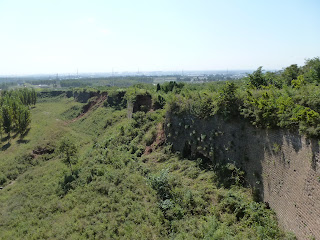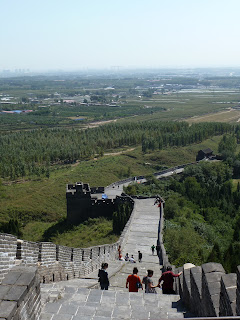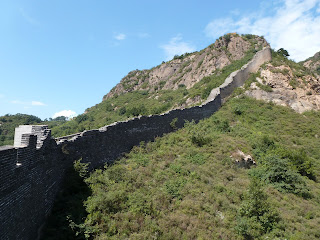Shanhaiguan (山海关; Shānhǎiguān) is about half way between Shenyang and Beijing. The name of this little city with only about 20.000 inhabitants can be translated as "connection or pass between mountain and sea".
The Great Wall wasn`t exclusively built to keep out Mongolian Riders from the Chinese Empire. It should also keep out the Manchus who lived here in the northeast with Shenyang as it`s capital.
To really,really,really deter outsiders from invading China the wall was built all the way from the adjacent mountains down onto the ocean, with the famous "Old dragon head" (lǎolóngtóu,老龙头) even descending some meters into the water, which was considered a natural barrier. Thought they already had ships back in the 14th century when they started constructing the wall in this area.....
The "old dragon head" is the last and most eastern segment of the great wall and can be seen on the first pictures.
If you`re familiar with the history of China you already know that the Manchu who were supposed to be kept out of China took over the empire in 1644 and became its last dynasty, the Qing dynasty. In favor of the Great Wall - the Manchus didn`t surround, destroy or climb the wall, they were allowed to pass by Chinese troops in hope they would help wipe out rebels that were threatening the capital Beijing. There are two different stories going around how it happened, I´ll quote wikipedia with both:
.
The second account of these events holds that Wu Sanggui surrendered to Li, but on his way to Peking (Beijing), he learned of the disorderly state of the capital and of the massacres perpetrated by Li's forces, as well as the murder of his own father. Enraged, he returned to Shanhaiguan and surrendered to the Manchu leaders. Wu's forces then fought in the front lines against Li's forces, deceiving them into believing the Manchus had not broken through. As a result, Manchu forces decimated Li's forces, using a cloth attached to the uniforms of Sanggui's troops as a way to differentiate friend from foe.
Directly adjacent to this section of the wall is a fort and barracks where the everyday life of soldiers of the Ming dynasty (the one overthrown by the Manchus) is exhibited.
It´s beautiful to walk through, but as the "old dragon head" section, it´s fake. Or "restaurated", if you will. The original fort and wall didn`t make it through the centuries, and Shanhaiguan is one of the many spots where sections of the wall (and the fort) were rebuilt since the 80s.
Leaves behind the slight feeling of walking through an ancient Chinese Disneyland, but still, we had a great time. Shanhaiguan is far less crowded than other "restaurated" wall sections, e.g. Badaling near the capital Beijing.
And you can have a peek at the "real wall", too, you just have to get out of town a couple of kilometers. What we did and what you`ll be able to see in the next section. But hopefully first enjoy the last pictures in this section...
Entry gates of fort and baracks
A look down at the most eastern point of the wall.
Afternoon walk at the beach. In the background: Ancient China (old dragon head) and Modern China (city harbor).
Jiaoshan 角山(jiǎoshān)
For the "real deal" you have to leave the city of Shanhaiguan and head for the mountains, which takes only about 20 min by taxi. There lies Jiaoshan, also called 天下第一山 (tian xia di yi shan) , "the first mountain under the heaven". Simply the first mountain the wall had to be constructed on starting from the sea....
.....where you`ll find both, a "restaurated" segment of the wall (built in 1986) linking to old sections down in the valley and on the top of the mountain.
This piece of the wall and the surrounding beautiful mountain scenery are also a popular setting for newly-weds getting their wedding pictures done, be it in (for China) traditional red.......
or modern, western white - whatever choice, the scenery is breathtaking.
When you first climb the wall, you`re immediately reminded you`re on a "new" piece of it by
1. a gift and souvenir shop
2. a red sign showing where to look to see the leftovers of the real wall.
What you can see then hardly reminds of a real fortification anymore. In the last hundred years or so nature has conquered back the unrestaurated part between the coast and this mountain. You still can see where the wall winds through the valley to the city of Shanhaiguan, but what you see has more in common with a dam or dyke than a real weir system.
Anyway, the goal was to reach the watchtower at the top, so we three (Sven & Sam, old friends from Germany, were visiting) started climbing.
And as you can see, the wall and it`s steps can be pretty steep. The guards in the old imperial days on the wall must have been in great shape patroling this segment. Or monkeys.
Above - about halfway to the the watchtower the view`s already amazing.
Left- as is the level of steepness. Sven standing "upright".
The last part naturally is the most exhausting one, as the steepness during climbing the last stairs takes up a notch.
When you`ve finally arrived at the base of the tower, you can choose wether you stay on the wall and climb up or take stairs that make you walk around the last section of the wall.
Either way, the view is breathtaking - if you look up or down.
Above you can see the end of the new wall piece and the beginning of the old one heading up all the way to the mountain top. It`s prohibited to enter for tourists.
To the right is the view down from the tower base.
 The last challenge then was to climb the tower itself on a rusty ladder for having a smoke and enjoying once more the fantastic view:
The last challenge then was to climb the tower itself on a rusty ladder for having a smoke and enjoying once more the fantastic view:Once more, the last few meters of the rebulit section converting into the old, unrestored, not passable section.
Above - breathtaking view from the highest watchtower
Right - me on the sidepath alongside the wall where we went back down on.
The last pictures also were taken from that path.
第一山 (dì yī shān), "the first mountain" written below the watchtower.







































Keine Kommentare:
Kommentar veröffentlichen